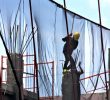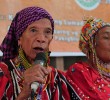Prepared by the Bagong Alyansang Makabayan
Since 2005, there has been a drastic leap in the number of activists killed under the Arroyo regime. Many questions have been raised on the nature, pattern, reasons and perpetrators of the killings. We are releasing this short primer based on frequently asked questions regarding the issue of political or extra-judicial killings.
1. Is there a national trend or pattern in the killing of activists under the Arroyo regime?
Yes. It is now beyond question that there is indeed a trend in the killing of activists. There have been 607 victims of extrajudicial killings documented by Karapatan (Alliance for the Advancement of Human Rights from January 2001 to May 30, 2006.
From January to May of this year alone, 75 have already been killed. There are also 25 victims of enforced disappearance.
Extrajudicial killings are politically-motivated killings perpetrated by state agents without the sanction of any law or court. This will include summary executions, assassinations, deaths due to strafing or indiscriminate firing and massacre. Summary execution is used when the victim is held passive before being killed (i.e. abducted then found dead). Assassination is used when the victim is killed at once. Massacre is the term used when there are three or more dead.
The killings do not happen in one area or region alone. A total of 136 victims of extrajudicial killings in Southern Tagalog region have been documented by human rights groups from 2001 to May 19, 2006.
From 2005 to May of this year alone, Karapatan-Central Luzon documented 98 victims of extrajudicial killings and involuntary disappearances. Twenty-three have been killed this year.
In the Bicol region, there were 71 victims of extrajudicial killings from January 2001 to December 2005. For the first five months of this year, five activist leaders have been killed. Sotero Llamas, former high-ranking leader of the New People�s Army (NPA) was also assassinated on May 29.
From 2002 to May 2006, the Southern Mindanao region has recorded 67 victims.
Fifty-three have been killed in the Eastern Visayas region. The highest death toll was registered in 2005 with 36 victims of extrajudicial killings.
These regions, except for the Eastern Visayas, are listed as priority areas in the AFP�s Oplan Bantay Laya (OBL), an internal security plan of the government. The OBL aims to destroy the Communist Party of the Philippines� (CPP) alleged political infrastructure and its alleged legal fronts. Under the said military campaign, the AFP targets the leaders and members of legal organizations.
2. Who exactly are the victims of extra-judicial killings?
The victims are civilians, unarmed, who had either pursued or supported political causes. Many are ordinary people.
Of the 601 victims of extrajudicial killings, 257 have been identified as activist leaders, members and supporters of cause-oriented groups. They belong to various people�s organizations and partylist groups who are struggling for genuine freedom and democracy. They are workers, farmers, lawyers, teachers, students, pastors, priests and even human rights advocates.
Human rights workers themselves are victims of extrajudicial killings. There have been 24 human rights advocates killed in the line of duty. One of them is Eden Marcellana, Karapatan-Southern Tagalog secretary general. She was abducted, along with her companions, on their way to a fact-finding mission on April 22, 2002. Her body was found a day after in Naujan, Mindoro Oriental. Signs of torture were apparent.
Another is Benjaline Hernandez, deputy secretary general of Karapatan-Southern Mindanao Region. She was killed on April 5, 2002 in Arakan Valley, North Cotabato due to indiscriminate firing.
Thirteen Church leaders and members have also been assassinated. Among them is Fr. William Tadena, of the Iglesia Filipina Independiente in Tarlac. He was shot dead on March 13, 2005. Fr. Tadena was a supporter of Hacienda Luisita workers. Another victim was Rev. Edison Lapuz, Conference Minister of the United Church of Christ in the Philippines. He was shot inside his home in Brgy. Crossing, San Isidro, Leyte on May 12, 2005.
The rest of the victims have no known political affiliation but have been killed in the course of military operations such as in the cases of indiscriminate firing and massacres. These often occur in communities that are labeled as �NPA supporters.�
Due to massive military operations in the countryside, peasants are the usual victims of extra-judicial killings, torture, forced evacuation and looting. At least 200 peasants have been killed in the course of these operations.
There were at least 60 women killed, based on Karapatan�s list. Even more alarming is the number of children who had been victims � 43, two of whom were unborn. Most of them were killed in massacres like Rey Corpin, 13 in the Kananga Massacre in Leyte. The Golloso siblings, Maylene, 13 and Raymund, 6 of Bgy. Recto, Bulan, Sorsogon were killed due to strafing. Elvin John Abilon, 5, son of an Anakpawis leader in San Marcelino, Zambales, died when armed men fired at their house.
Moreover, there were 59 workers who had been victims of extrajudicial killings. They were killed due to labor-related disputes. Eight of them were workers and supporters of the Hacienda Luisita including Ricardo Ramos, president of Central Azucarera de Tarlac Labor Union (CATLU) and Tirso Cruz. Another is Diosdado Fortuna, president of Nestle-Cabuyao labor union.
3. Who are the perpetrators?
A study on the means, motives and opportunity behind such killings points to the elements of the Armed Forces of the Philippines (AFP) and/or their agents like the Civilian Armed Force Geographical Unit (Cafgu) and death squads.
The AFP, being the biggest armed group in the country, has the means of launching such offensives on a nationwide scale. It has enough resources and manpower to undertake a systematic attack on the progressive movement.
Death squads are motorcycle-riding men wearing masks and armed with high caliber pistols or rifles. Karapatan records show that there were 41 killings that involved this kind of operation, and were implemented nationwide.
Pronouncements by the regime�s Cabinet Oversight Committee for Internal Security (COC-IS) reveal the motives behind the killings. Its members include General Eduardo Ermita, National Security Adviser Norberto Gonzales, Justice Secretary Raul Gonzalez, Defense Secretary Avelino Cruz, AFP Chief of Staff Gen. Generoso Senga, and PNP Director General Arturo Lomibao.
As early as 2004, Norberto Gonzales named the progressive party-list groups Bayan Muna, Anakpawis, Gabriela, Anak ng Bayan, Suara Bangsa Moro and Migrante as communist fronts.
In a Powerpoint presentation �Knowing the Enemy� released by the AFP in the first quarter of 2005, more legal organizations, including church groups and journalists� groups, were branded as communist fronts. In the book trilogy �Trinity of War�, the Northern Luzon Command (Nolcom) further identifies alleged front organizations of the Communist Party of the Philippines and the NPA.
The state security forces� motives for undertaking extrajudicial killings is summed up in its widely circulated view that progressive legal organizations and mere �communist fronts� and are thus enemies of the state.
In many incidents, state armed forces and agents also have the opportunity to carry out the �neutralization� of their targets. Neutralization is the euphemism used by the military for physical elimination of killing. Pieces of circumstantial evidence to the killings prove this.
Adelina Golloso, mother of Maylene and Raymund, saw how elements of the 2nd Infantry Battalion and the 902nd Infantry Brigade of the 9th Infantry Division of the Philippine Army fired at their house on May 7, 2004.
Reaching home from some errands, Adelina shouted at the soldiers to stop. She saw her daughter Maylene, 13 and her son Raymund, 6, lying on the ground, bathed in blood.
She asked for the soldiers� help but the latter just walked away. The next day, military officials claim the incident at Bgy. Recto was a legitimate encounter with the NPA.
Eyewitnesses testified before the court that the twin killing of Eden Marcellana and Eddie Gumanoy is the handiwork of then Col. Jovito Palparan Jr. Witnesses, who were abducted along with the two, point to the �Bonnet Gang,� a paramilitary group linked with the Philippine Army�s 204th Infantry Battalion of which Palparan was the commanding officer.
The cases of murder of Eden Marcellana, Eddie Gumanoy, Benjaline Hernandez and Edilberto �Choy� Napoles Jr. have been filed in the local courts. Napoles, Bayan Muna member in Mindoro Oriental was killed by the �Bonnet Gang� on May 28, 2002. There are witnesses and enough evidence that point to the elements of the military as perpetrators but justice has not been served. Their cases have been elevated by Karapatan to the United Nations Human Rights Committee.
Many received death threats from the military before they got killed.
Bayan Muna member Ricardo Uy, was killed on Nov. 18, 2005 at about 11 a.m. inside his own rice mill in Barangay Basud, Sorsogon City. Two Saturdays before Ding�s death, a radio program run by the Philippine Army in dzMS Sorsogon City, �Ugnayan sa Kapayapaan� (linking for peace), maliciously tagged him as an �emerging leader� of the NPA.
Another victim, Marcelino Fabula of Anakpawis-Pagsanjan in Laguna, was interrogated by a certain Lt. Andy Veneracion of Camp Lusiana. On Dec. 4, 2005, Fabula was shot dead by Jacinto Losano, a CAFGU member closely linked with Veneracion.
Before his death, Marcelino Beltran�s house was frequented by soldiers based in Tarlac. Ka Marcing, an eyewitness to the Hacienda Luisita Massacre, was killed on Dec. 8, 2004, days before he could have testified before the Senate.
Victor �Ka Ben� Concepcion, Anakpawis coordinator for Mexico, Pampanga and chair of provincial peasant organization, experienced the same. Before being killed on March 17, 2005 inside his home in Angeles City, Ka Ben noted increased military surveillance. He reported to his colleagues how suspected agents of the Northern Luzon Command (Nolcom) surrounded his home in Anao, Mexico.
Fact sheets, eyewitness accounts, direct and circumstantial evidence (as strong as the former) point to the elements of the AFP and their death squads as perpetrators.
4. Who must account for these killings?
Mrs. Arroyo, being the commander in chief, is liable for the extrajudicial killings. It took her almost five years and more than 500 victims before she ordered an investigation through the formation of the Task Force Usig. The Commission on Human Rights (CHR) said it correctly that the State should be responsible in protecting its people. The Arroyo administration is at the very least liable for its failure to protect its people. At the most, the Arroyo administration is liable for the killings through its tacit approval or direct involvement in these crimes.
The PNP task force, which has not even started its job, has already embarked on the propaganda line that these killings are the product of a communist purge. The creation of the task force only means to reinforce the lie being peddled by the COC-IS. Thus, it has become apparent that the government is more interested in spreading intrigues of a purge rather than going after the perpetrators of the killings.
The regime�s COC-IS should be made directly accountable for the killings. The cabinet security cluster formulates and implements such repressive measures as the calibrated preemptive response, the Marcosian PP 1017 declaring a state of national emergency, and even the order for the arrests and detention of known progressive leaders such as the Batasan 6. Batasan 6 is composed of six progressive party-list representatives.
With the scale and magnitude of the killings, it is clear that there is a national policy at work which could only emanate from a very high and powerful cabinet cluster.
It is interesting to note that during the term of General Ermita as the AFP Deputy Chief of Staff for Operations, motorcycle riding assassins were used to destroy then Partido ng Bayan, a progressive political party. Today, many of the killings have been done by the same death squads.
In the 1960s, Ermita was in Vietnam and worked with John Negroponte, the current director of the U.S. National Intelligence. Negroponte was notorious for human rights abuses in Honduras in the 1980s. Records show that Negroponte sanctioned the use of death squads, euphemized as a “special intelligence unit” of Battalion 3-16 of the Honduran armed forces, which kidnapped, tortured and killed hundreds of people.
Negroponte also served as U.S. ambassador to Iraq from June 2004 to April 2005, the same time Gen. Palparan served as the head of the Philippines� humanitarian mission to Iraq.
Early this year, Negroponte went to the Philippines and met with National Security Adviser Norberto Gonzales and Ermita. One raises the question if the Negroponte visit affirmed U.S. support for the repressive measures employed by the Arroyo administration.
5. Why are the activists being killed?
The Arroyo regime is waging all-out war against people�s movement. The progressive movement is the most organized and most determined among the many forces fighting the regime. Weakening the progressive movement will also weaken the broad anti-Arroyo united front.
The extrajudicial killings complement other forms of political persecution aimed at the national leaders of progressive party-list groups and people�s organizations. The regime thinks that by killing and harassing the activists and their leaders, it could terrorize the Filipino people and prevent any popular uprising.
US imperialism, for its part, considers the progressive movement as a threat to its economic and political interests in the country. It is in the strategic interests of the U.S. to eliminate anti-imperialist, anti-feudal and anti-fascist resistance in the Philippines.
6. What can we do?
There is a need to step up protests to condemn these killings. All forms of protests must be undertaken to expose the state policy of repression.
- Intensify protest actions against political repression. Launch widespread protests and information drives. Whenever there is a reported killing, a quick reaction team (QRT) must be mobilized to hold an indignation protest. A picket rally in front of the Department of National Defense (DND) or of the camp where the alleged AFP unit is based may follow days after the incident.
- Hold fora and other forms of educational discussion in schools, offices and communities. Discuss the current state of human rights and the Oplan Bantay Laya.
- Write letters to the editor, leaflets. Create stickers, button pins and other visual propaganda and multi-media presentations that will articulate our call for justice and an end to these killings.
- Get the support of institutions (i.e. Church, local government unit), organizations, personalities and individuals. Link up with other victims of repression. Encourage them to speak against these killings. Launch joint activities with them whenever possible.
- Appeals before international human rights watchdogs is also important to exert pressure on the regime. Write letters to as many international organizations as possible.
- More importantly, we must struggle for the immediate removal of the fascist US-Arroyo regime. It is her desperation to stay in power that incites this slaughter of political dissenters.
Stop the killings!
Justice for all the victims of state repression!
Uphold human rights!
End the fascist US-Arroyo regime!
Sources:
Karapatan-National Office
Karapatan-Southern Tagalog
www.gitnangluson.com
www.bulatlat.com
www.inq7.net�










